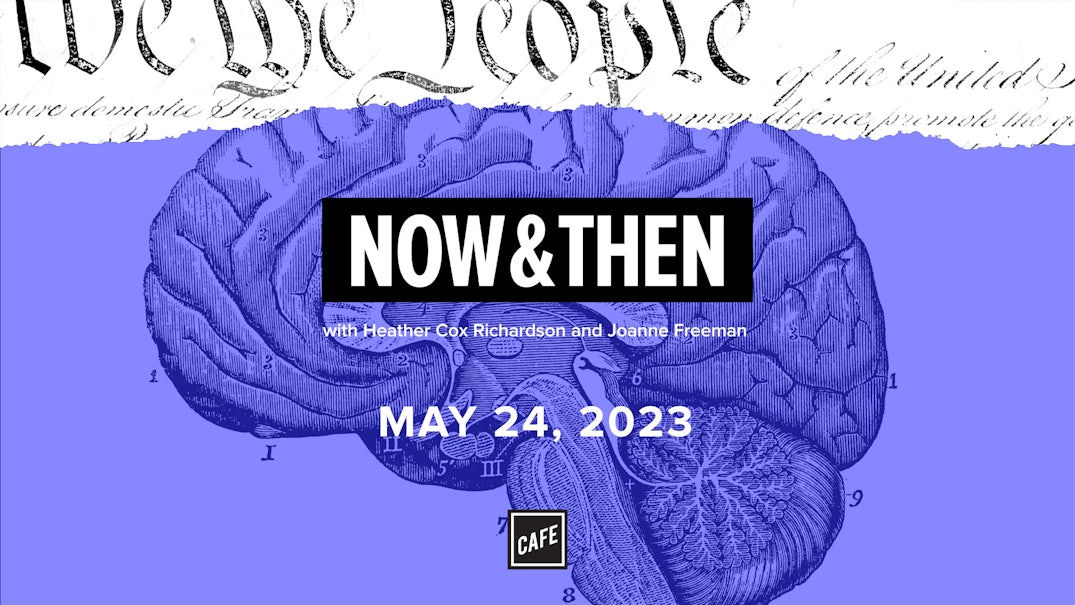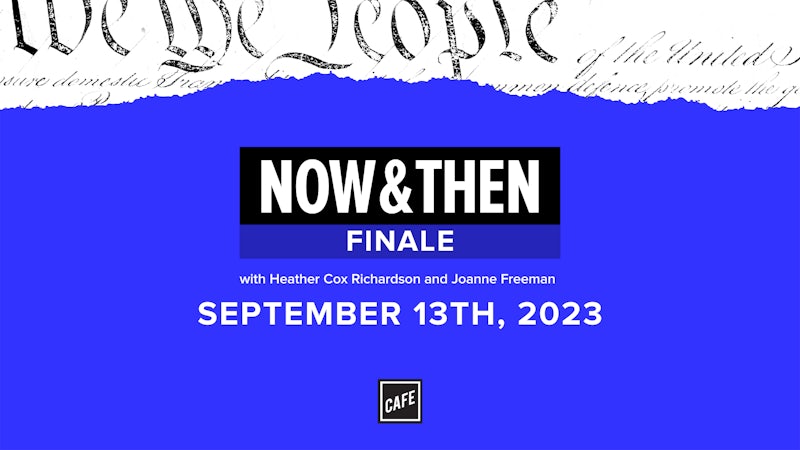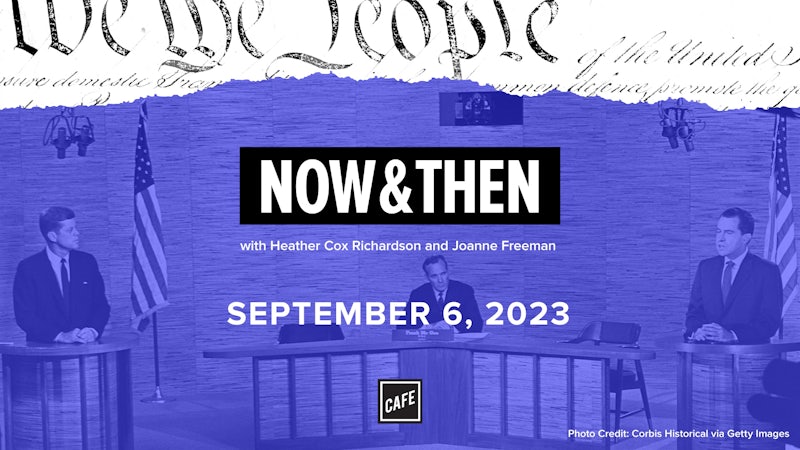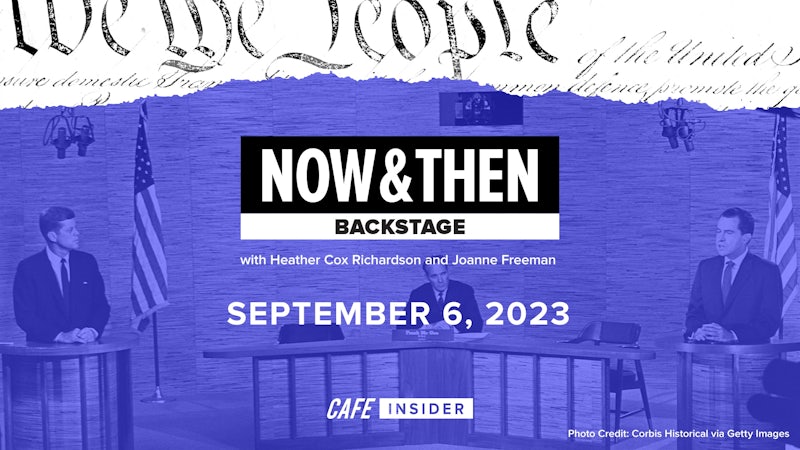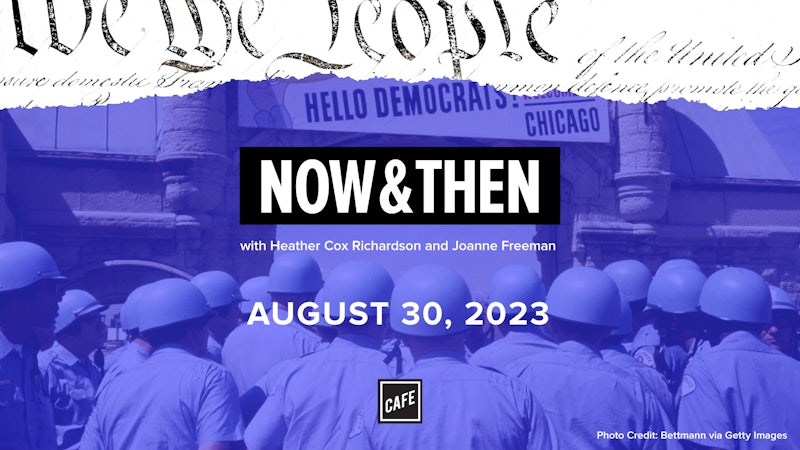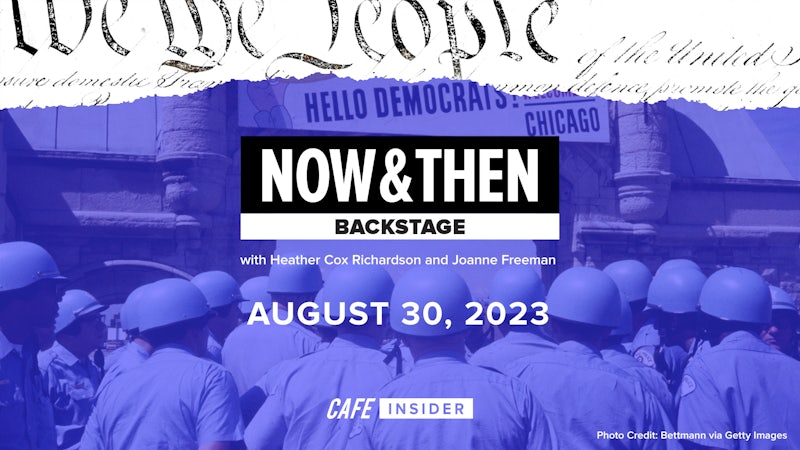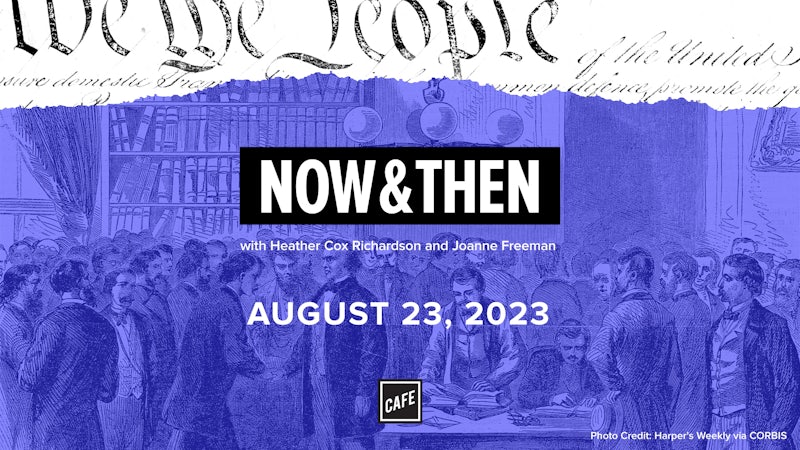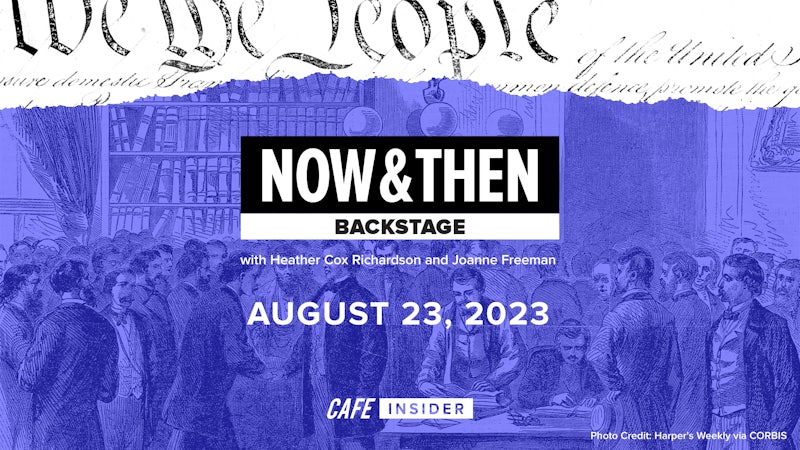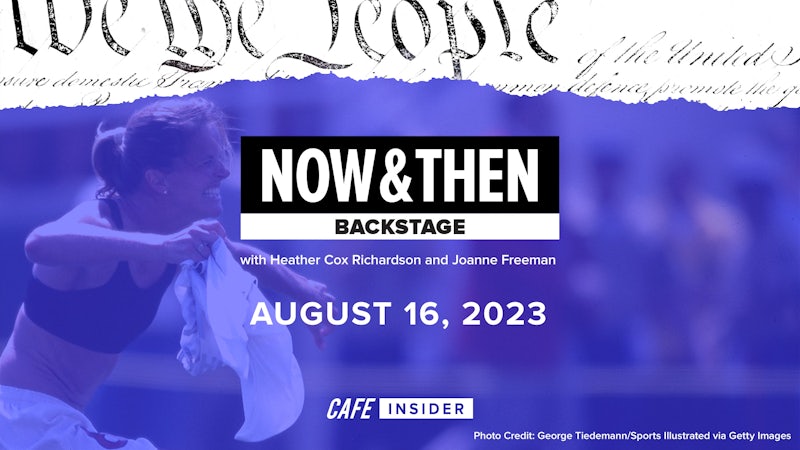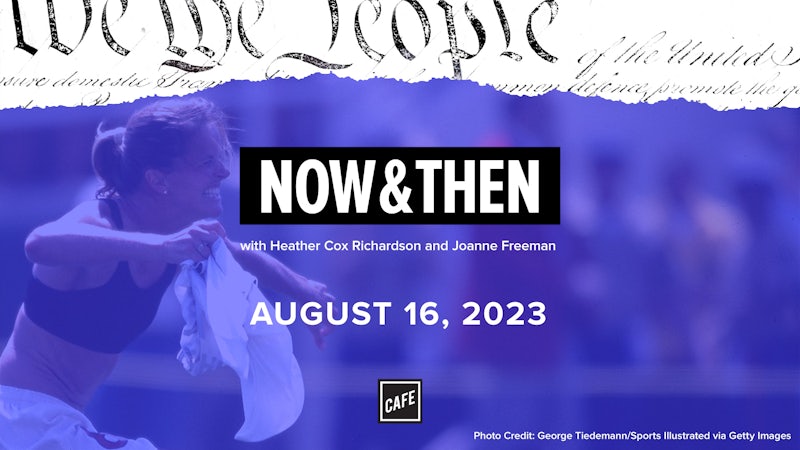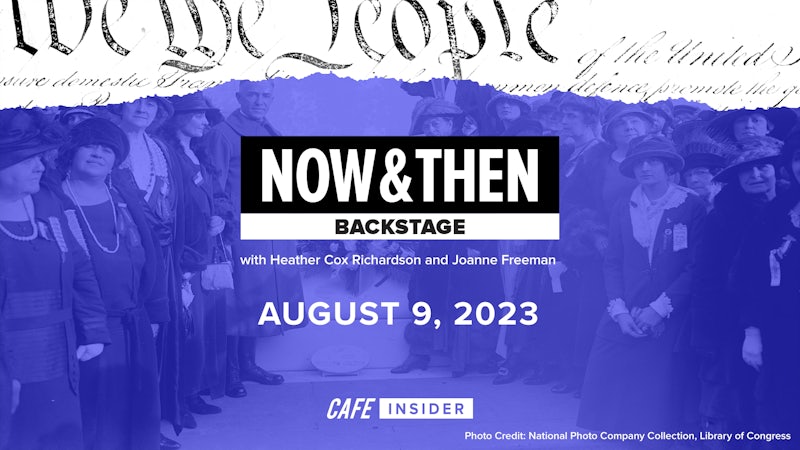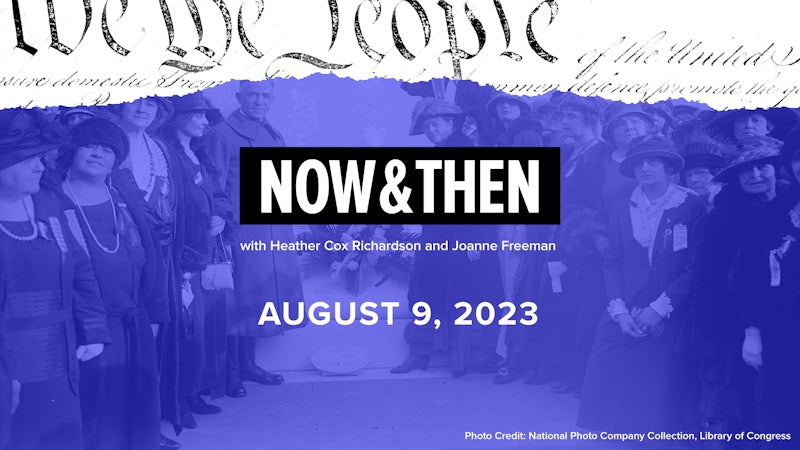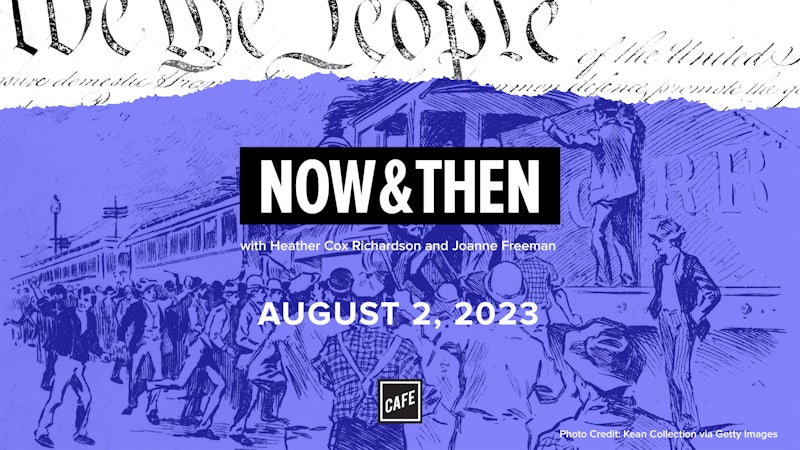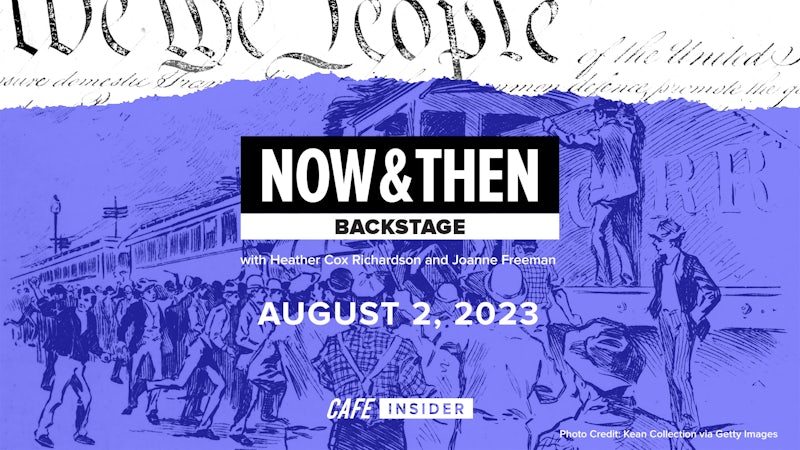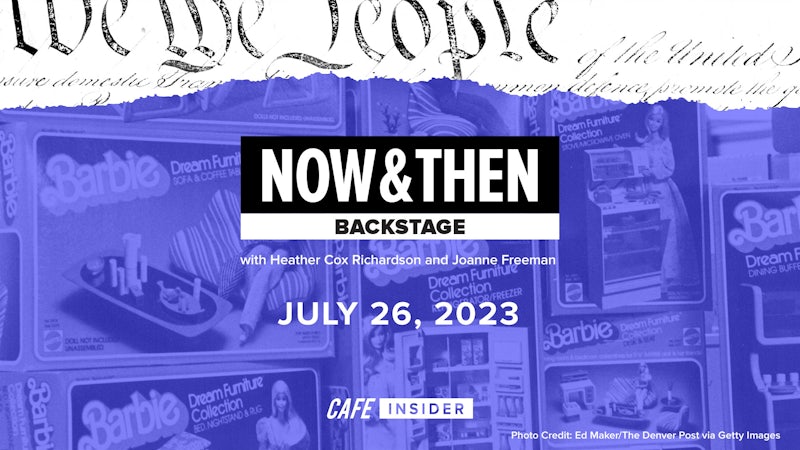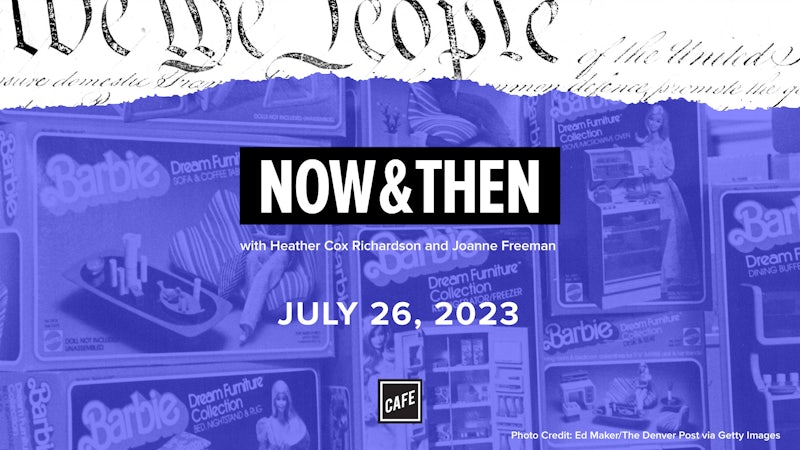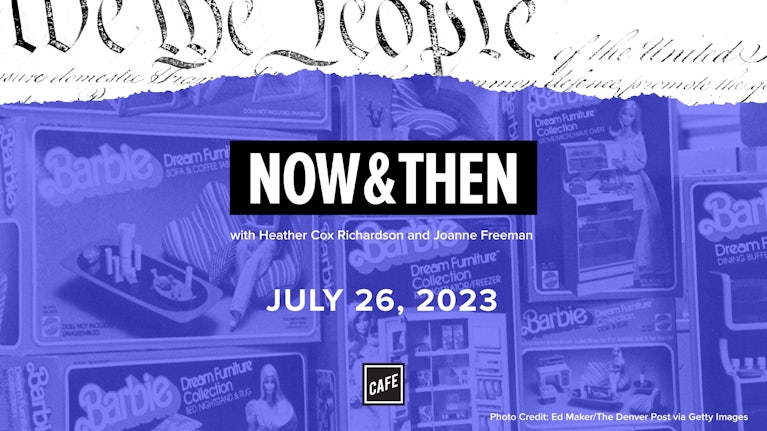Heather Cox Richardson:
From Cafe and the Vox Media Podcast Network, this is Now And Then. I’m Heather Cox Richardson.
Joanne Freeman:
And I’m Joanne Freeman. This week we’re going to begin a two-part series on ideas about wellness throughout American history. And for this first episode, we want to talk about something that in one way or another has certainly been, no pun intended, on people’s minds recently, and that is mental health. And obviously this is tied to the fact that the world has been going through a pandemic, that there have been a variety of other kinds, certainly in the United States, of major components causing stress, whether you’re talking about politically or socially as far as just basic health is concerned. And because of that, there has been a lot of talk, and I’ll bet a lot of people who read generally in the news have seen people talking about, uh-oh, it’s a mental health crisis or a mental health crisis is coming in one way or another. Arthur Evans, who’s the CEO of the American Psychological Association, declared that a mental health tsunami was coming. And May, this month, happens to be Mental Health Awareness month.
The idea of mental health being a concern is not new. What’s interesting about our current moment is that it feels immediate and it feels relevant because we’re smack in the middle of a moment where all are responding to all of these events and feelings and abnormalities. And the question is, what’s a normal response to what’s going on now? People talk a lot about what is going to be the new normal, what is normal in the face of major change like this, and how does that change over time?
Heather Cox Richardson:
Yes, what is normal and who gets to define what is normal, is a question that we’ve been dealing with in US history since, well, the beginning. We are though in a moment where people are paying a great deal of attention to what they think should be normal. According to a study in 2022 by the American Psychological Association, more than eight in 10, that is 84% of psychologists who treat anxiety disorders said they have seen an increase in demand for anxiety treatment since the start of the pandemic. And demand for treatment of depression is also up with 72% of psychologists who treat depressive disorders saying they have seen an increase as well. The Director of the National Institute on Drug Abuse, Dr. Nora Volkow, said, “The Covid-19 pandemic exacerbated numerous social stressors that we know can increase the risk of both substance abuse and mental illness.”
And that crisis is particularly bad among young Americans. The Centers for Disease Control and Prevention did a study in February that said that 42% of American students reported feeling in quotes, “persistently sad or hopeless.” And those numbers are even higher in marginalized groups. Many of them have not been formally diagnosed with or treated for any kind of disorder, but they are feeling it. And according to the CDC, social media has played a role in making the crisis worse.
Joanne Freeman:
So an example of a response to that is actually pretty recent. In March of 2022, president Biden announced a quote, “National Mental health Strategy to strengthen system capacity, connect more Americans to care and create a continuum of support, transforming our health and social services infrastructure to address mental health holistically and equitably.” And that’s resulted in a kind of whole government approach affecting many, many different programs. One proof point is that the President’s 2024 budget proposes a $656 million budget for mental health crisis care across departments.
Now, an important point to make here is we’re launching into this episode is what do we mean by normal? What do we mean when we’re talking about mental health? And a major component, and I think it’s probably not natural, I think we tend to think in terms of yes and no categorization, something either is something or isn’t something, but as we’re going to see throughout this episode, what people consider to be mental illness or mental health evolves and changes a lot over time in part in response to cultural changes, in response to changes in society, that it’s fluid and it largely reflects us. It reflects where we are and what’s happening generally speaking in the world at a given point.
Heather Cox Richardson:
If we talk about the idea of mental illness, that refers to conditions that affect the way people think, their emotions or their behavior. Formal clinical definitions now have more information in them.
Joanne Freeman:
That actually reflects a change in how people are thinking about mental health. Basically in the 1960s and 1970s, people were focused on illness and they diagnosed disorders. And in more recent decades, it isn’t a matter of diagnosis. It’s actually, you look at a person and see strengths and weaknesses and determine the best way to treat that person. So in a way, the emphasis now is wellness, it’s not illness.
Heather Cox Richardson:
And I think this is really what we’re driving at in this episode is the relationship between society and the whole of human beings and how those things got defined over time and what that says about the eras in which that kind of idea happens.
Joanne Freeman:
I think a great example of this sort of thing is just think in a general way about two issues that are not at the center of this episode, but that really show you the ways in which ideas of normality and abnormality can change over time. So for example, homosexuality until the early 1970s was deemed a pathology, a disease by the American Psychiatric Association. And it actually involved lobbying from gay rights activists that drove that kind of change. “Gender non-conformity” was considered a mental disorder until 2013 when it was no longer described that way in the DSM, the Diagnostic and Statistic Manual of Psychiatric Disorders, which is kind of the Bible of psychiatric disorders. So there are two issues that now we’re dealing with in intermediate way and that within recent decades have been redefined, reunderstood in a sweeping kind of way.
Heather Cox Richardson:
I always pick on you for making you define the early republic, but one of the things that jumps out to me about the way people understand mental health is that in the colonial era, the people who lived then defined what they considered normal along religious lines. So if you didn’t fall within those religious lines for whatever reason, and it might be things that nowadays we simply consider normal behavior, talking back to your parents, for example, you were possessed by demons or you were listening to the devil or you were somehow religiously afflicted. And the transition from that to recognizing that bodies and the thing inside those bodies might have its own relationship to nature is actually a really big step forward in understanding human health.
Joanne Freeman:
And in a sense, it’s not surprising that this comes along towards the end of the 18th century. The late 18th century is the so-called age of revolutions where there’s revolutionary change of all kinds, not just governments happening everywhere. So people are open to radical change and new ideas. In addition, it’s the enlightenment, and during the enlightenment, science and the study of science and understanding science in a different way is on the rise. And you put those things together and it’s hardly surprising that in the late 18th century, not just in the United States, but other places in the world as well, people are beginning to rethink what they would’ve understood as mental illness. What it is that it probably isn’t being possessed by demons, but that there’s a physical cause for it, and that in one way or another that physical cause can be treated.
Heather Cox Richardson:
So walk us through that. I’m guessing we’re going to go with somebody who’s playing around in medicine.
Joanne Freeman:
We are indeed. We’re going to go with Philadelphia’s Dr. Benjamin Rush, who is a founder who is engaged in and influential in the politics of revolutionary and early national America. But he’s a trained doctor, trained overseas, trained in Edinburgh, and brought those skills back. And he comes to have a real interest in mental health and how people should be treated when they appear to be mentally ill. And on this very idea that we just mentioned, that it isn’t a matter of demonic possession, that it’s not a manner of the moon being in a certain phase, that it actually is a physical disorder of sorts that you can treat as one might treat any other kind of illness.
So Rush was born near Philadelphia in 1745. He graduated from the College of New Jersey, which is now Princeton University at the age of 14. And by the age of 24 he’s practicing medicine in Philadelphia and he’s a professor of chemistry at the College of Pennsylvania, now the University of Pennsylvania.
Heather Cox Richardson:
Worth pointing out here that college colleges at this time were often much more rudimentary educations than they are currently. So the fact that he graduated from Princeton at 14 does not indicate he was a child prodigy necessarily, although obviously he’s very smart.
Joanne Freeman:
So in 1787, Benjamin Rush was charged with supervising the care of what were called maniacal patients at the time in the Pennsylvania hospital. And in doing that, he developed new ideas about mental illness that really changed what was becoming the field of psychiatry. So for example, he was a believer in what we now call talk therapy. That speaking out, talking about your problems in one way or another might be helpful. He thought that in one way or another, occupational therapy would be useful. He wrote a really highly influential book that came out in 1812 called Observations and Inquiries About the Diseases of the Mind, in which he talks about the idea that activity might be a way in which you could help people get beyond mental illness.
He wrote, “It has been remarked that the,” and this is the word they’re using at the time, “maniacs of the male sex and all hospitals who assist in cutting wood, making fires and digging in a garden, and the females who are employed in washing, ironing and scrubbing floors often recover, while persons whose rank exempts them from performing such services languish away their lives within the walls of the hospital,” which is a far cry from demonic possession and hoping that God cures a person who in some ways is “abnormal.”
So Rush determined that what he called madness was a physical state. This is actually a statement by Rush. “I infer madness to be primarily seated in the blood vessels. From the remedies, which most speedily and certainly cure it being exactly the same as those which cure, fever or disease in the blood vessels from other causes.” So he’s making that kind of direct connection. And one of the things that he does along those lines that is sort of notoriously assigned to him, he creates a kind of chair, a kind of tranquilizer chair in which you are essentially tied down to a chair sitting up. He didn’t like straight jackets because he thought that made people lie down and blood flow, blood circulation would not be proper. But in his tranquilizing chair, blood circulation would be going along the lines that it should go. And he even created a kind of box to put over the heads of people who were in that chair so that they wouldn’t be upset by too much stimulation going on around them.
So one can certainly argue that that hardly seems like a moral caring mode of dealing with someone who is in mental distress, but it’s a far cry from putting someone in a basement and beating them until they’re quiet, which is what would’ve happened in so-called asylums in an earlier time. This is the period, this revolutionary period, when Americans are beginning to experiment with asylums. Along these very lines, what does it mean? We can have buildings where we put people and treat people who are mentally ill. Rush actually gets funds and creates a new wing in the Pennsylvania hospital that’s just devoted to treating mental illness. So that’s a big change in this period about how people understand mental illness, about how people think it should be treated and the fact that it can be cured.
Another example of Rush linking mental health with the physical body was a kind of gyrator, which was their word for it, and it was intended to deal with what was called at the time, torpid madness, but probably is essentially depression. And if you were experiencing depression, you would be put on a rotating board that would spin the patient at a high rate of speed to stimulate more blood flow to the brain.
Heather Cox Richardson:
Okay, I like the idea of this.
Joanne Freeman:
And this, I would be howling.
Heather Cox Richardson:
Yeah, no. I am like, “Okay, just keep me moving. We’ll be good.”
Joanne Freeman:
You can have another episode, Heather, on here and my completely opposite reactions. But yeah, I don’t know what I would do in that. I think I would be howling and trying to get out and I would not be submissive and quiet.
Heather Cox Richardson:
But there’s another piece of that actually, the helplessness on the part of the patient in this, what is for the time, a humane approach to disorder is absolutely terrifying. I mean, if you’re in Rush’s hands, I suspect you don’t have the option of saying, “Well, Dr. Rush, I’m not entirely sure this is effective.” When you’re strapped to that chair, you’re there till he says you’re not.
Joanne Freeman:
Right. I’ve had students write about cases in which someone is declared mad and institutionalized in some way and doesn’t think he is and has friends who don’t think that he is and has other friends or family who do. And what do you do with that person?
Heather Cox Richardson:
Well, that’s Mary Todd Lincoln, right? I mean, it’s a later period, but it seems fairly clear that under the circumstances that she is institutionalized, that basically her son’s got a real problem with her spending habits and her interaction with the world, and he gets her committed without her having legal representation or anything else.
Joanne Freeman:
And actually this nicely brings us to the next topic we want to talk about because it has really powerful sexist or gendered components to it. And that is a disease that was massively widespread at the time and then vanished and very much was a product of social and cultural changes of the moment and was seen as something serious and treatable in men and was treated very differently in women. And that’s neurasthenia.
For more Cafe history content, check out Time Machine, a weekly column by our editorial producer, David Kurlander, inspired by each Now And Then episode.
Heather Cox Richardson:
You can receive the Time Machine articles through the free Cafe brief email. Sign up at cafe.com/brief.
The concept of neurasthenia begins after the Civil War and it comes from the Greek term for lack of nervous energy. And it exhibited itself through a series of symptoms that included headaches, muscle pain, weight loss, irritability, anxiety, impotence, and depression. And when Joanne says it’s everywhere, you don’t do the 19th century without reading about neurasthenics, as they were called and people who had the disease, as it was characterized at the time, of neurasthenia.
Joanne Freeman:
So now we’re at a point where it’s not like, oh, there are some people who are abnormal and should we institutionalize them? Now we’re, it’s something that increasingly becomes, wow, a thing that many people are suffering from.
Heather Cox Richardson:
And because so many people are suffering from this illness, medical care professionals look at it as a symptom of a diseased society, not just of individuals who are somehow outside the norm. And so Americans in the 19th century came to understand the rise of this disease because they recognized in their era that it was a new disease and they came to recognize it as a reflection on industrializing society and how industrializing society weakened the body, disjointed the mind, and unraveled gender norms.
Joanne Freeman:
So what you have here is in essence a different kind of logic in which people are saying society has changed, culture has changed in drastic ways that don’t yet feel normal. They sort of feel over the top. And so neurasthenia in many ways is a logical response to the nature of the times.
Heather Cox Richardson:
But one of the pieces about neurasthenia that I find fascinating is that there was a cultural understanding that it could be treated, that human beings who were suffering from neurasthenia could be fixed. And those people suffering from neurasthenia usually were members of the middle or the upper class and they were usually white. So this was a specific kind of disease that afflicted people who were benefiting from the new post-war industrial society, but who were not adjusting to it particularly well.
So the way we get to understanding Neurasthenia is that 30 year old Yale medical school graduate and a staff doctor at the College of Physicians and Surgeons of New York named George Miller Beard began to popularize the term neurasthenia in 1869. He wrote extensively about what caused neurasthenia, the societal environmental elements of that, and in 1881 he wrote a book called American Nervousness, Its Causes and Consequences. He argued that it was an inherently American phenomenon, it was mostly prevalent in the northeast factories and it came from technological and social advancements.
Joanne Freeman:
So Beard described or talked about neurasthenia in a way that I think captures the fact that it is a middle and upper middle class disease. This is his description of it. “The chief and primary cause of this development and very rapid increase of nervousness is modern civilization, which is distinguished from the ancient by these five characteristics, steam power, the periodical press, the telegraph, the sciences, and the mental activity of women.” That’s the cause of neurasthenia. And again, the periodical press, people reading newspapers, the telegraph, people communicating faster than ever before, women actually thinking and expressing their thoughts, these are all things that one might think had a class angle to them in addition to a racial angle.
Heather Cox Richardson:
One of the things that’s cool about Beard is he thinks that one of the things that America can do to deal with neurasthenia is to change the people who live here. He suggests that if the United States encourages more German immigrants to the United States, they can get rid of the growth of neurasthenia because he says, “As the Germans in their temperament are the opposite of the Native Americans,” and by that he means native born Americans, not indigenous Americans, “this process promises to be in all respects, beneficial, encouraging in every way out of door life and amusements tending to displace pernicious whiskey by less pernicious beer and wine setting. The example of coolness and calmness, which the nervously exhausted American very much needs.” And what he said is that there were three central questions that were really upsetting Americans in the late 19th century. They were worried about, here are the three questions, how should we keep from starving? Who shall be the next president and where shall we go when we die?
Joanne Freeman:
How do we stop from starving? Where do we go when we die? Who’s going to be the next president? It tells you so much about that moment in time.
Heather Cox Richardson:
So well, Beard, one could even argue, created this disease by naming it and defining it. There is a different doctor who decides how to treat it, and this I find fascinating. His name is Dr. Silas Weir Mitchell, and he is the military surgeon at Philadelphia’s Turner’s Lane Hospital during the Civil War where he began to experiment with what he called the Rest Cure on soldiers that he described as being weary soldiers. We would probably now recognize them as having some form of PTSD from their experiences on the front lines. After the concept of neurasthenia begins to take off in the 1870s, Mitchell begins to call for a Rest Cure for both men and women, but men’s treatment is going to change pretty quickly. He calls for a Rest Cure for women. Mitchell’s Rest Cure consists of being stuck in bed and eating a diet of fatty foods for six to eight weeks. Sometimes by force. You were not supposed to exercise, you were supposed to rest entirely, although on occasion you could have massages by nurses.
Joanne Freeman:
To me, it’s evidence of how much more intimidated and frightened people are in this period by women stepping forward. We have them being bound, restrained, and sort of force-fed food. It’s a rest cure that so represents a reaction to women frighteningly gaining new freedoms when having a louder voice.
Heather Cox Richardson:
Well, and from this we get a very famous piece of American literature about the Rest Cure written by Charlotte Perkins Gilman, and it’s known as the Yellow Wallpaper. People probably know this. It is a truly terrifying short story in which a woman who was actually one of Mitchell’s patients and who had been assigned to the rest cure after the birth of a child, her rest cure, her being stuck in a bedroom, she is literally put in an old nursery. So she gradually is infantalized until by the end of the short story. She’s crawling around the room and you know from the way she writes about it that she has done it so much that her shoulder has worn the wallpaper off around the room because she’s deteriorating, because she is so cut off from the world. She later went on to write in 1913 about how this rest cure just affected her as negatively as it did.
She said, “I went home and obeyed those directions for some three months and came so near the borderline of utter mental ruin that I could see over. Then using the remnants of intelligence that remained and helped by a wise friend, I cast the noted specialist’s advice to the wins and went to work again. Work, the normal life of every human being, work, in which is joy and growth and service without which one is a popper and a parasite, ultimately recovering some measure of power.” And it’s based on that that she wrote, as I say, the Yellow Wallpaper, where this controlling husband confines his wife into a nursery and essentially turns her back into a child.
Joanne Freeman:
What’s striking to me is that at the same time that you have women being restrained in these radical ways, and this is so typical of the gendered component of medicine, you have other medical figures who blame what is called neurasthenia among men and women. They say, “Oh, they’re just sort of following trends. They’re just being stylish.” So for example, there’s an author named Augustus Hoppin and in 1883 he published a book called A Fashionable Sufferer in which he attacked neurasthenic women. And this is from that book, “A luxurious civilization has begotten a new order of invalids who exists on the sweet council of their physician and the daily administration of loving friends.” He suggested that many women are just well enough to go to the opera and the play, just sick enough not to go to church.
So here we have a kind of double whammy, right? Oh, women, we need to restrain them, we need to give them a forced “rest cure,” or we need to ignore them when they themselves are complaining about feeling ill and blame it on them being fashionable and really not thinking on a reasonable and serious level. Also, what’s underlying these forms of logic is the basic assumption that the norm is men.
Heather Cox Richardson:
What they are arguing for to treat neurasthenia, which is a disease in their time, the modern world, is an exaggeration, almost a cartoon version of what they see as gender roles. So women need to go back to the nursery. I mean women need to get out of the public sphere, they need to lay in bed and eat food all day. And then in contrast to that, men become manly men. Men who are suffering from neurasthenia are in fact supposed to indulge in the camp cure, which Mitchell popularized in a book in 1877 called Nurse and Patient and Camp Cure. And Camp Cure is quite literally what it sounds like, men need to go back to nature.
Joanne Freeman:
As Mitchell himself explained it, “Civilization has hurt, barbarism shall heal. In a word, my tired man who cannot sleep or who dreams stocks and dividends and awakens leg heavy and who has 50 other nameless symptoms, shall try a while the hospital of the stone carver, he shall reverse the conditions of his life, want to live in a house, he shall sleep in a tent or despite his guide’s advice shall lie beneath the ‘moon’s white benediction’.” So the camp cure is getting over civilization by going back to nature and he uses the word barbarism, getting out of the namby-pambiness of regular society and going back into a manly kind of climate to change your mental state.
Heather Cox Richardson:
So I love this because I’m a huge fan of the book, the Virginian by Owen Wister. And Owen Wister was somebody who took the Camp Cure and he goes out west in 1885 to go rough it in Wyoming where he instantly began to feel better. He wrote, “I’m beginning to feel I’m something of an animal and not a stinking brain alone.” And in the book the Virginian, the character of the narrator is somebody who has gone west for a cure and is observing Western life and gradually becoming a real man because of his experience out there. The book is also dedicated to somebody who was making a big name for himself, embracing the idea that men needed to go out in into the Western wilderness, and that was Theodore Roosevelt, and that becomes obviously a bestselling novel. It’s so worth reading, it’s got so much in. It becomes a bestselling novel. It also becomes really the first respectable Western novel. There had been plenty of that really after 1872, but it’s really that one that puts the Western on the map as being the iconic piece of American literature.
Joanne Freeman:
So not surprisingly, given that neurasthenia was everywhere, there are two things that begin to happen. On the one hand, modernity begins to seem less strange and abnormal. On the other hand, in 1895, a young Sigmund Freud published an article entitled, On the Right to Separate from Neurasthenia, A Definite Symptom Complex As Anxiety Neurosis and the popularization of his ideas, his psycho analytical concepts begins to chip away at this idea that there’s this all encompassing nervous condition and what you need to do, as you suggested earlier, Heather, is push people into an extreme version of what they should be and what they should be limited to or what they should be. So restrain women and make more manly men.
Freud visited the United States in 1909 and gave a series of lectures at Clark University that proved to be highly influential in this move away from neurasthenia. And generally speaking, his argument was that most neurasthenic diagnoses were in fact, and people who know anything about Freud won’t be surprised by this, more specifically sexual in nature and that they should be diagnosed and treated as sexual abnormalities often linked to childhood trauma, which is a dramatic shift from, society is causing this response in people to, people themselves and the experiences of their particular life, generally even particularly sexual in nature, are moving people in a direction that it is upsetting their mental state. It’s a dramatic change in the nature and understanding of mental disorder.
Heather Cox Richardson:
What it cracks open the idea of there is something holistically disordered about that individual, you’re on the outside. Instead, it starts to say, Hey, wait a minute here, let’s start to break down what those pieces might look like. There are pieces here that we can break apart and address individually, which is a huge leap.
Joanne Freeman:
And you are in the process of doing this. You are taking part in what might be called the talking cure, which means unlike before where you can’t really say anything that’s going to affect your condition, you’re declared a them and institutionalized or restrained in some way, now it’s all about talking to the patient, getting a sense of the patient of what their life experience and how they feel about different things and using the information from the patient to begin to understand the chain of ideas and thoughts and emotions that are leading people to move in a certain direction.
Heather Cox Richardson:
That shift, that idea of being able to pinpoint or at least more clearly define mental discomfort coincides with the rise of the pharmaceutical industry in the 20th century, which is the third aspect we wanted to deal with. How? The pharmaceutical industry, especially since the 1950s, has opened up new ways to treat Americans in distress even as those same changes have led to real pushbacks, both from the philosophical communities and the psychiatric communities at the idea that in fact people can be overmedicated as well. So this has opened up a whole new kind of way of looking at mental distress.
So the rise of American antidepressants actually comes out of World War II when in the final years of World War II, Germany, which was low on ethanol, began to use hydrazine as rocket fuel for the v2 rocket. Hydrazine is a chemical compound. When the war ended, a lot of hydrazine was left over and chemists around the world continued to experiment with the potential pharmaceutical applications of this mysterious compound. And that compound becomes the parent of what is known as monoamine oxidase inhibitors or MAOIs. And MAOIs ultimately become the first mass marketed modern American antidepressant.
Joanne Freeman:
Now what’s interesting about this is it’s not as though scientists went looking to solve that problem with medicine. They were doing other kinds of scientific research first related to World War II and rocket fuel. Then in 1952, two tuberculosis researchers, Irving Selikoff and Edward Robitzek were exploring using hydrazine drugs to treat tuberculosis and found that one of those drugs in particular seemed to stimulate the central nervous system in patients undergoing clinical trials. And they commented on what this meant, what these supposed treatments for tuberculosis seemed to do for people. They wrote, “So accentuated has been the feeling of the sense of wellbeing that disciplinary measures have been necessary. The feeling of wellbeing may be due to a resurgent animal vigor.”
Five years later in 1957, Dr. Nathan Kline, who was a director of research in the New York State Hospital in Rockland County, organized a clinical trial of these drugs for 17 patients with schizophrenia and seven patients with clinical depression.
And they were particularly effective for patients suffering from depression. The New York Times wrote about this very excitedly in 1957, “The drug,” they reported, “has produced remarkable mood improvement in activity among long-term ‘untouchable psychotic’ of the ‘burned out kind’ as well as among non hospitalized neurotics.” Kline, based on this development and on the response appeared before a house appropriation subcommittee in February of 1958 to argue for more federal funding for antidepressant research, and he expressed optimism for these what he called, psychic energizers, and argued that American leadership in the global manufacturer and distribution of these drugs could usher in a peaceful brand of “power politics.” Again we’re we have politics coming right on back in here.
Kline said, “In this present day and age, we must as a nation take into account the reaction of world opinion. The hundreds of letters which we have received from foreign countries inquiring about the use of the new psycho pharmaceuticals as well as the letters of gratitude from various places in the world describing their dramatic results, make it evident there is a different and superior type of power politics, the power of the United States to develop treatments which will relieve suffering throughout the world and return to gainful employment hundreds of thousands of individuals now incapacitated by mental and emotional illness.”
This is fascinating to me. Now we get to a point where we’re not just talking about society and where people who don’t seem to fit in society should go. We’re not just talking about getting men and women to fit back into the place where people want them to be. Now we’re talking about a form of drugs that’s going to treat depression, is going to help mental disorder, and in doing so, it will bring power to the United States.
Heather Cox Richardson:
That’s 1957 when he is talking in front of Congress. I’m going to count here my fingers. Five years later, Rachel Carson is going to write Silent Spring about the dangers of chemicals, and that is in a sense, a picture of the way the use of antidepressants is going to play out after the 1960s. On the one hand, the first antidepressant drug to hit the American market initially was a version of the drug that Kline had been using in the clinical trials, and within three years, 400,000 Americans had been prescribed the drug. It was pretty quickly taken off the market because it caused liver damage. But by the time that happened in 1961, a number of safer antidepressants had entered the scene and the federal government was also increasingly supportive of the research of antidepressants and tranquilizers.
So in 1963, February of 1963, president John F. Kennedy came out in support of antidepressants, issuing a special message to Congress, encouraging further funding and support for antidepressant research. He proposed a national mental health program to assist in the inauguration of a whole new emphasis and approach to care for the mentally ill. This approach relies primarily upon the new knowledge and new drugs acquired and developed in recent years, which make it possible for most of them mentally ill to be successfully and quickly treated in their own communities and return to a useful place in society. New drugs proliferate across the United States, and by 1965, an estimated 4 million Americans were taking antidepressants. Between 1956 and 1964, the resident population of psychiatric hospitals decreased 9.7% in part because of the effectiveness of the new antidepressants.
Joanne Freeman:
Now, not surprisingly, as a major development, there is some pushback. I just want to mention one form of pushback in particular because it brings us right back to where we started and the larger question driving this episode.
So in the late 1960s, there’s an anti psychiatry movement that becomes powerful in American counterculture. A psychiatrist named Thomas Szasz became kind of the leader of this idea of anti psychiatry. In 1961, he published the Myth of Mental Illness, which rejected a lot of medical approaches to psychiatry. There should be other ways of treating what he is deeming normalcy, bringing people to normalcy, and he speaks out about what he thinks health and happiness are and how we define them, and how certain things are good and how certain things are bad. So basically, once again, we have someone talking about what is normalcy, how should we think about it, and how do different people define it over time?
Here’s one person who steps forward and says, “No, no, I know about normalcy and I think we should do it in different ways.” It’s part of an ongoing conversation we’ve seen throughout this episode of different definitions of how people are mentally ill or mentally healthy, different ways in which that’s treated, which have a lot to do with what society is like at a given moment, and then the impact that that has on people generally, who is deemed in, who is deemed out?
We started by talking a little bit about homosexuality and transgender issues. They’re being talked about now as part of this ongoing conversation about people trying to draw lines about what is “normal” and what is not.
Heather Cox Richardson:
Our conversation continues for members of Cafe Insider.
Joanne Freeman:
Heather, and I take you behind the scenes of each episode in a special segment of Now And Then that we call, Backstage.
Heather Cox Richardson:
So join us Backstage and get an inside look at the thoughts we’re wrestling with as we prep for our weekly conversations.
Joanne Freeman:
Head to cafe.com/history to join.
Heather Cox Richardson:
That’s cafe.com/history.
Joanne Freeman:
That’s it for this episode of Now And Then. If you like what we do, please rate and review the show on Apple Podcasts or wherever you get your podcasts. It makes a big difference in helping people find the show. Your hosts are Joanne Freeman and Heather Cox Richardson. The executive producer is Tamara Sepper. The editorial producer is David Kurlander. The audio producer is Matthew Billy. The Now And Then Theme music was composed by Nat Wiener. The Cafe team is Adam Waller, David Tatasciore, Sam Ozer-Staton, Noa Azulai, and Jake Kaplan now and then is presented by Cafe and the Vox Media Podcast Network.












